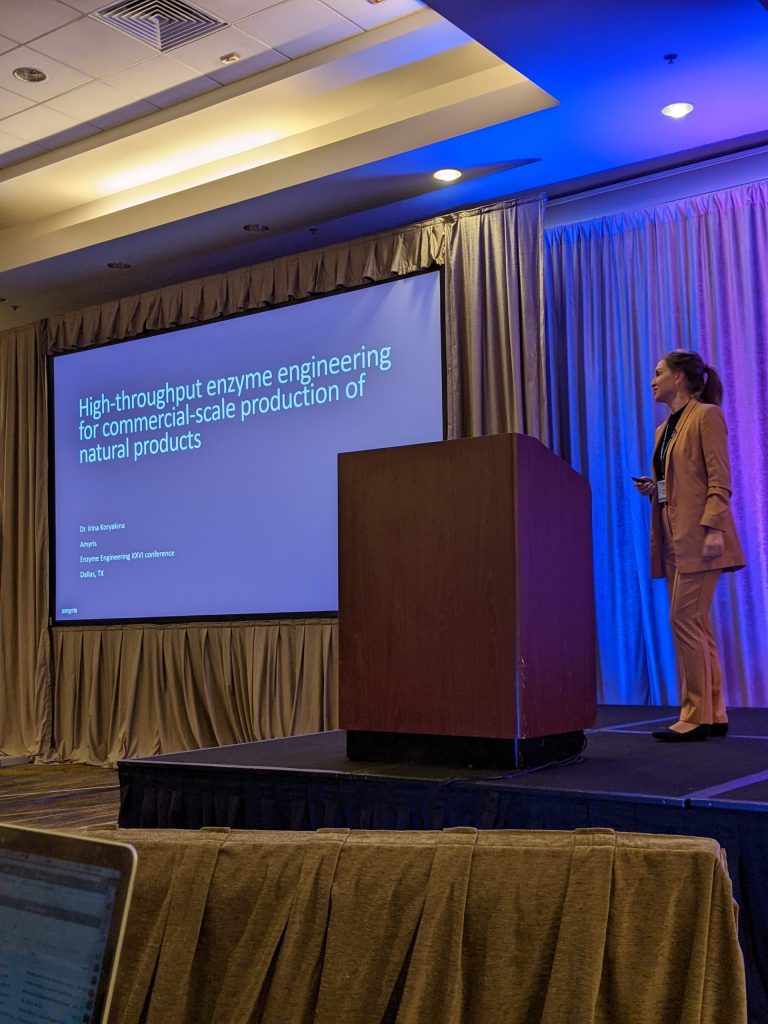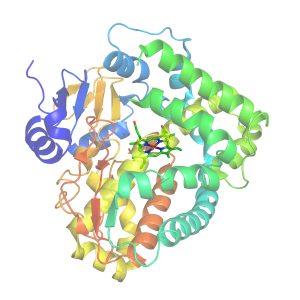
Like nearly everything in life, biotechnology and, specifically, synthetic biology depends on the power of enzymes to make products – whether that be in flavors, fragrances, food, or personal care. Most enzymes do not need to be incredibly efficient and are naturally good enough to do their jobs in their organism, which is a living system, such as a plant, animal, and even yeast. However, synthetic biology requires highly efficient and active enzymes and as a result, synthetic biologists must engineer enzymes to improve their functionality.
Enzyme engineering is a critical part of Amyris’ R&D strategy that has given the company a crucial commercial advantage. Its R&D team has honed its enzyme engineering process and developed a powerful enzyme engineering pipeline, which has played a vital role in bringing new, sustainable products for consumers.
As of August 2021, BCC Research reported the global market for enzymes in industrial applications is estimated to grow to $8.7 billion by 2026. Every ingredient – and therefore every consumer product – that Amyris produces is made possible by a unique set of enzymes that catalyze an essential step in the biosynthetic pathway of the target molecule. With Amyris’ consumer brand revenue reaching nearly $35 million in Q1 2022 alone, it is evident just how impactful enzymes are to Amyris’ portfolio, as well as the larger market.
Engineering for Optimization
Enzymes evolve naturally in every organism to perform a specific function required for the organism to operate at its fullest potential. While an enzyme can work perfectly well in its natural environment, this does not mean it is operating as quickly or effectively as it could – simply because it doesn’t need to. But when manufacturing at industrial scale with synthetic biology, the organism must be producing the target molecule as quickly and effectively as possible, which is where enzyme engineering comes into play.
Unsurprisingly, engineering enzymes is a challenging technical feat. There are two primary ways an enzyme can be engineered: in vivo (within the living cell itself) or in vitro (in a test tube that is then transferred back into the living cell). Most enzyme engineering in an industrial setting is performed in an in vitro (outside of a living cell) context. This comes with complications, as many scientists will attest, often resulting in failure to perform when the engineered enzyme is placed back into a living system.
Amyris is atypical in that its scientists engineer enzymes in vivo – or within the living cell and in the context of the cellular environment and its full pathway to the end product. This ensures that any improvement engineered in the enzyme will deliver the intended results. Amyris has developed an integrated, high-throughput pipeline that combines computational support with automation to rapidly build and test tens of thousands of variants of an enzyme and then isolate improved versions. Amyris has perfected these processes to the point that its enzyme engineering is highly effective, efficient, and repeatable across its pipeline of targets.
Amyris’ investment in fine-tuning its enzyme engineering capabilities has been essential to its success in bringing more than 13 sustainable ingredients to market and advancing its mission to shift the world to sustainable consumption.
The Future of Enzyme Engineering
Amyris has honed its enzyme engineering process and it is a key part of the company’s product development cycle. Ten years ago, it took two or more people and upward of two years to successfully engineer a single enzyme; today, a typical enzyme improvement campaign can be completed in six months or less by a single enzyme engineer. In addition, Amyris can now improve upwards of 20 enzymes in a given year, which is an order of magnitude higher than what was possible a decade ago. Enzyme engineering will undoubtedly remain a critical component of Amyris’ product development and the success of synthetic biology at large.
In May, Irina Koryakina, PhD, Scientist at Amyris, presented at the Enzyme Engineering XXVI Conference in Dallas, where thought leaders and industry specialists came together to discuss emerging technologies and the future of the field. She shared an overview of the work performed by the Amyris team using the company’s high-throughput enzyme engineering pipeline, which sparked interest among attendees around the use of automation and miniaturization.
“This year’s conference brought together some of the brightest minds in the industry and it was a pleasure meeting with so many people leading the way for enzyme engineering,” said Dr. Irina Koryakina, Scientist 3 at Amyris. “From new machine learning techniques to computational tools to novel enzyme discoveries and process modelling, the conference was an impressive demonstration of the innovation happening in the space and I’m proud to see Amyris at the leading edge.”

An Amyris Use Case: Reb M
While people around the world work to reduce their sugar intake, demand for alternative sweeteners has exploded – but most alternative sweeteners still leave a bitter aftertaste and don’t perform well in baking and cooking applications. One of Amyris’ most successful ingredients to date is Reb M, a no-calorie, low glycemic index sweetener made by via fermentation.
Reb M is the sweetest molecule in the stevia plant but is present in very low concentrations (< 0.1%), making it incredibly difficult to access in high quantity and quality, and largely unavailable for use in alternative sweeteners. Using biotechnology, Amyris developed the ability to sustainably produce industrial volumes of theReb M ingredient for sale and distribution through commercial partners and in 2019, also launched its own consumer sweetener brand, Purecane.
Behind Amyris’ successful Reb M launch was an impressive feat of enzyme engineering. This single ingredient entailed:
● 17 new enzymes inserted into the yeast
● 8 enzyme biodiversity searches to find the best enzymes present in nature with optimal activity to make the molecule in an in vivo platform
● 6 enzyme improvement campaigns to improve activity and/or specificity of the enzymes found in nature

Amyris’ development of enzymes to produce high quantities of Reb M required its R&D team to screen hundreds of thousands of enzyme variants, using analytical chemistry to measure the behavior and performance of each enzyme’s potential. As a result, Amyris also developed a screening pipeline that is significantly faster than what is commonly found in the industry. In addition to screening for improved variants one-by-one with analytical chemical approaches, Amyris also developed methods that allowed for direct selection of improved enzymes in a cell. In this scenario, called growth-coupled selection, mutagenized enzyme variants – of which there could be more than a million – are inserted into cells (each cell gets one variant) and then the millions of cells carrying different enzyme variants are placed in a growth chamber to compete among each other. The enzyme variations that allow the cell to grow the fastest will eventually dominate the population of cells in the growth chamber. Scientists then recover the cells and find the enzyme variant(s) that confer the best activity for the cell.
Had Amyris not invested in its enzyme engineering capabilities and infrastructure, the development of Reb M would have been impossible. With the natural sweetener industry projected to reach $5.33 billion this year (per The Business Research Company), the launch of Reb M offers huge market potential for Amyris, while also giving consumers what they’ve long sought after – a delicious sweetener they feel good about eating.
Source
Amyris, press release, 2022-06-30.
Supplier
Share
Renewable Carbon News – Daily Newsletter
Subscribe to our daily email newsletter – the world's leading newsletter on renewable materials and chemicals









